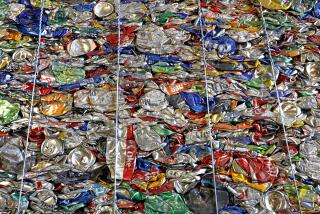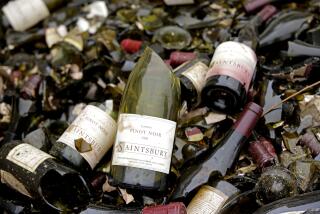A Hundred Bottles of Beer, a Thousand Cans of Beans; You’ll See Them All Again
- Share via
Despite California’s new legislation encouraging recycling of all beer and soft drink containers, aluminum cans remain the most economically attractive for recycling.
Aluminum cans are light and easy to transport, and recycling saves about 90% of the energy required to extract aluminum from bauxite ore. In a typical recycling operation, unwashed cans are shredded, melted at 1,100 degrees to 1,200 degrees Fahrenheit, cast into ingots and rolled into sheets.
The sheets are then used to manufacture new cans. Washing the old cans is unnecessary because “when they go into the furnace, any impurities rise to the top and are skimmed off,” says Peter Whited, regional manager of Reynolds Aluminum Recycling Co. in Orange.
Glass needs to go through a process called “beneficiation” before it can be recycled. Old bottles are crushed, run under huge magnets to remove lids and other metal impurities, sifted, and then vacuumed to remove labels.
The resulting material--called “cullet”--can then be used in place of the sand, soda ash and limestone that are ordinarily used to manufacture glass. Any remaining impurities are vaporized in the 2,700-degree Fahrenheit furnace.
Bottles must first be separated into clear, green and amber (glass dyes do not separate from the molten glass), but despite the inconvenience the use of cullet provides major benefits.
“The higher the concentration of cullet, the lower the melting point,” explains Owens-Illinois recycling manager John T. Holzemer. “That translates into energy savings, longer furnace life and less pollution.”
More to Read
Inside the business of entertainment
The Wide Shot brings you news, analysis and insights on everything from streaming wars to production — and what it all means for the future.
You may occasionally receive promotional content from the Los Angeles Times.










